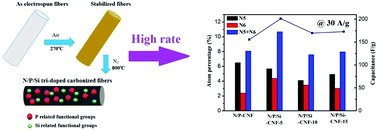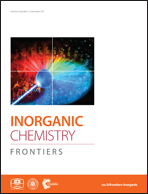Eco-friendly fabricated nonporous carbon nanofibers with high volumetric capacitance: improving rate performance by tri-dopants of nitrogen, phosphorus, and silicon†
Abstract
Development of high volumetric capacitance, high rate performance and low-cost electrode materials for supercapacitors is still a significant challenge. Among the various promising candidates, carbon nanofibers (CNFs) with heteroatom functionalization have attracted increasing attention. Herein, a type of nonporous CNFs combined with a heteroatom functionalization strategy is proposed for high performance supercapacitor electrodes. Tri-heteroatom functionalization of nonporous carbon nanofibers was carried out by tetraethyl orthosilicate (TEOS) and phosphorus (H3PO4) activation of polyacrylonitrile (PAN) through electrospinning and subsequent thermal treatment. The optimal electrode material showed a high gravimetric capacitance of 243.7 F g−1 at 0.5 A g−1, superior rate capability with ∼83% retention at rates ranging from 0.5 A g−1 to 30 A g−1 and excellent cycle stability (capacitance retention rate >100% after 8000 cycles at a high current density of 30 A g−1). It is worth noting that the nonporous CNF also possesses a high packing density, which presents a maximum volumetric capacitance of 253.4 F cm−3 at 0.5 A g−1 and 209 F cm−3 at 30 A g−1. The current synthetic strategy of preparing nonporous carbon architectures with multi-heteroatom doping offers an eco-friendly, feasible, and cost-effective way for constructing high-performance electrode materials employed in supercapacitors.



 Please wait while we load your content...
Please wait while we load your content...